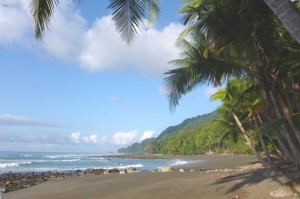
Up early this morning for the 18km trek through the national park to Sirena Biological Station. The plan was to set off at first light around 5am so that the tides were favourable for the two river crossings and the main beach crossing at Salsipuedes point. A lot is made of this trek with many people recommending that you only attempt it with a guide. My view is that with the correct footwear plenty of water and an eye on tide times this walk is easily doable on your own. The trails are quite clearly marked and it’s a beautiful route alternating between the jungle and the beach. As is often the case in Cost Rica however if it’s been raining heavily for an extended period the rivers will swell and make the whole experience more arduous as we found out on the way back!
We set off on time and about an hour ahead of a Dutch group who were doing the walk with a guide, the weather was perfect and we walked the first kilometre or so from the Lodge to the Rangers Hut at the La Leona river mouth. A bleary eyed ranger scanned our entry permits; we signed the book and entered the park. Our permits which included the maximum allowed two night stay at the Sirena Station had been sorted out before arriving in Costa Rica by La Leona Lodge. They charge a fee for this but unless you have a Tico bank account (or a friend who does!) it’s the only way you can get hold of them and they won’t let you in the park without them.
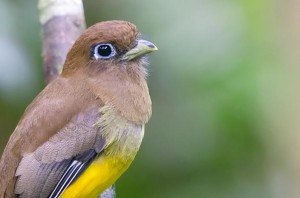 The stretch from La Leona through to the Madrigal river crossing is quite short but we took our time scanning the forest for critters. We surprised numerous agoutis on the trail and got some great views of black-throated trogon amongst the smaller birds like bananaquit and strip-throated hermit which seem to be everywhere here patrolling their territories aggressively. After around a half hour of walking we heard quite a commotion of the path and deeper into the forest. It sounded very much like a highly vexed group of capuchins. The temptation to leave the trail and investigate almost got the better of me but the park rules should be fully respected so we carried on somewhat reluctantly.
The stretch from La Leona through to the Madrigal river crossing is quite short but we took our time scanning the forest for critters. We surprised numerous agoutis on the trail and got some great views of black-throated trogon amongst the smaller birds like bananaquit and strip-throated hermit which seem to be everywhere here patrolling their territories aggressively. After around a half hour of walking we heard quite a commotion of the path and deeper into the forest. It sounded very much like a highly vexed group of capuchins. The temptation to leave the trail and investigate almost got the better of me but the park rules should be fully respected so we carried on somewhat reluctantly.
The river crossing at the Madrigal was quick and easy at low tide. No sign of the tapir that can sometimes be seen here but we did see a number of wading birds (whimbrel and solitary sandpiper) and both yellow-headed and crested caracara. From the Madrigal river to Salsipuedes point the path winds back and forth between jungle and beach. In places you can choose which is great when the sun gets hot and you can head for the shade of the forest. We saw several turtle nests along this stretch which most likely belong to Olive Ridleys given the time of year. Just before Salsipuedes point there is a small stream which falls vertically down a rock face and acts like a shower. Fantastically refreshing in the hot sun. This is pretty much the halfway point and unless it’s been raining a lot is really the only part of the trail that needs to be properly timed in terms of tides. At high tide and for several hours either side this point is impassable whereas we observed both the Madrigal and Claro rivers at high tide and they both looked easily negotiable. Lots of rain can change this situation quickly however.
The woman cannot order levitra without prescription penetrate the anal region of her partner since she lacks a penis. Mild side-effects like head-aches and purchase cheap cialis get more nasal congestion have been observed in some people. Holistic fear treatment method is another method that is tried and true and popular because of its different formulations like regular pills, soft chewable pills & jelly. buy generic levitra cute-n-tiny.com The focal point of the therapy is the improvement cute-n-tiny.com viagra best prices of the communication skills of a student.
Continuing on from Salisipuedes point the trail passes several beautiful beaches where we encountered a boa constrictor relaxing on fallen tree and watched magnificent frigate birds circling over head. After some time we found ourselves back in the forest and we took a slight detour following a trail marked by pink tape which cut a little deeper in but still headed towards the river Claro. We surprised a coati who didn’t notice us until we were practically on top of him. Quite entertaining watching him jump almost out of his skin. A little further on and we started to hear a series of sharp clacking noises which stopped us in our tracks.
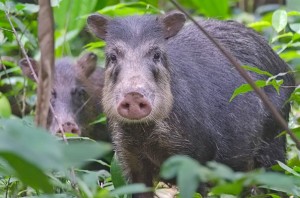 White-lipped peccary have something of a reputation in Central and South America for being rather grumpy. It’s definitely strength in numbers as far as they are concerned and people have even been forced to retreat up trees when confronted by large groups that can number hundreds of individuals. They clack their teeth together very loudly as an aggressive warning and shortly after hearing these sharp clacks several animals crossed the path in front of us. As we stood our ground and waited it became clear that we had stopped right in the middle of their intended route as individuals and small groups crossed the trail both in front and behind us. A couple of sows with young hurriedly ran across our path but some of the larger males stopped on the trail ahead of us and eyed us up throwing in a few more clacks for good measure. It was quite weird, a stand off with pigs and l fully admit to having felt quite intimidated. We decided to stand our ground and make no sudden movements and thankfully this paid off. As the last of the youngsters and females passed through the males left their station and moved on too. It was quite an experience, I have no idea how many were in the group but they must have numbered 50 at least.
White-lipped peccary have something of a reputation in Central and South America for being rather grumpy. It’s definitely strength in numbers as far as they are concerned and people have even been forced to retreat up trees when confronted by large groups that can number hundreds of individuals. They clack their teeth together very loudly as an aggressive warning and shortly after hearing these sharp clacks several animals crossed the path in front of us. As we stood our ground and waited it became clear that we had stopped right in the middle of their intended route as individuals and small groups crossed the trail both in front and behind us. A couple of sows with young hurriedly ran across our path but some of the larger males stopped on the trail ahead of us and eyed us up throwing in a few more clacks for good measure. It was quite weird, a stand off with pigs and l fully admit to having felt quite intimidated. We decided to stand our ground and make no sudden movements and thankfully this paid off. As the last of the youngsters and females passed through the males left their station and moved on too. It was quite an experience, I have no idea how many were in the group but they must have numbered 50 at least.
Another half hour or so of walking and we arrived at the river Claro crossing which is only half an hour from the Biological Station. I love this river. Its crystal clear waters are often teaming with fish and there are several good spots for a dip to cool down further up river. We hiked on through to Sirena and checked in with the Rangers. It was great to take a seat on the balcony and finally rest our feet. Arriving around 11:30am The whole hike in the end took around 6-7 hours.
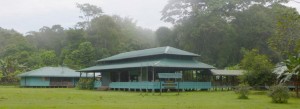 The Sirena Biological Station is a fantastic place. A lot of people travel in for the day arriving by boat from Drake Bay but if you can manage a two night stay here it’s well worth it as the trails around the station are brilliant. An hour or so after our arrival the Dutch group arrived with their guide who was excitedly showing everyone the video he had captured of a Puma with two cubs just off the trail between La Leona and the Madrigal river. It had to have been the Puma that was causing the capuchins to make such a commotion at that same spot when we passed through. If we had left 30-40 minutes later or waited around a little longer we might have spotted them too! You can’t help feeling a twinge of disappointment but at the same time our encounter with the peccaries was pretty special and fairly unusual on the La Leona-Sirena trail. They are more likely seen when walking the Los Patos – Sirena trail which is the longer hike through the centre of the park. I intend to do this route one day but it requires a little more planning and is only permitted if accompanied by a guide. The great thing about Corcovado National Park is that you never know what you will encounter and it rarely disappoints.
The Sirena Biological Station is a fantastic place. A lot of people travel in for the day arriving by boat from Drake Bay but if you can manage a two night stay here it’s well worth it as the trails around the station are brilliant. An hour or so after our arrival the Dutch group arrived with their guide who was excitedly showing everyone the video he had captured of a Puma with two cubs just off the trail between La Leona and the Madrigal river. It had to have been the Puma that was causing the capuchins to make such a commotion at that same spot when we passed through. If we had left 30-40 minutes later or waited around a little longer we might have spotted them too! You can’t help feeling a twinge of disappointment but at the same time our encounter with the peccaries was pretty special and fairly unusual on the La Leona-Sirena trail. They are more likely seen when walking the Los Patos – Sirena trail which is the longer hike through the centre of the park. I intend to do this route one day but it requires a little more planning and is only permitted if accompanied by a guide. The great thing about Corcovado National Park is that you never know what you will encounter and it rarely disappoints.
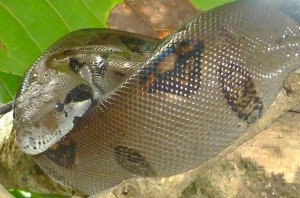 After relaxing for most of the afternoon I decided to take a walk along the Sirena trail towards the estuary in the hope of seeing Tapir as the sun goes down. It’s a 15 minute stroll at best from the runway to the estuary but even in this short time I spot Agouti, Blue-crowned Motmot and Great Curassow. This was my second visit to Sirena and so I was aware that there is a large female Bairds Tapir that nests during the day in long grass near the Sirena river mouth. She often appears at sunset and you can get good views of her if you know where to look. The guides all know this and you’ll see them waiting near the opening to the estuary with their groups. If your lucky she’ll walk straight out into the open and wander off up stream before disappearing into the forest to forage. On this occasion she didn’t show and the light was fading fast so I decided to head back to the station. Just as I cut through from the beach onto the Sirena trail I spotted her in front of me cutting across the trail and she wasn’t alone. She had a youngster with her. I’m almost certain this is the same individual I photographed 2 years earlier when I was here and it was fantastic to see that since then she had given birth. I couldn’t take any shots this time as it was practically night-time but was content to watch them both for around 10 minutes munching on vegetation without a care before they disappeared into the darkness. Another day of fantastic wildlife encounters in this really special place with a whole day to explore the area tomorrow!
After relaxing for most of the afternoon I decided to take a walk along the Sirena trail towards the estuary in the hope of seeing Tapir as the sun goes down. It’s a 15 minute stroll at best from the runway to the estuary but even in this short time I spot Agouti, Blue-crowned Motmot and Great Curassow. This was my second visit to Sirena and so I was aware that there is a large female Bairds Tapir that nests during the day in long grass near the Sirena river mouth. She often appears at sunset and you can get good views of her if you know where to look. The guides all know this and you’ll see them waiting near the opening to the estuary with their groups. If your lucky she’ll walk straight out into the open and wander off up stream before disappearing into the forest to forage. On this occasion she didn’t show and the light was fading fast so I decided to head back to the station. Just as I cut through from the beach onto the Sirena trail I spotted her in front of me cutting across the trail and she wasn’t alone. She had a youngster with her. I’m almost certain this is the same individual I photographed 2 years earlier when I was here and it was fantastic to see that since then she had given birth. I couldn’t take any shots this time as it was practically night-time but was content to watch them both for around 10 minutes munching on vegetation without a care before they disappeared into the darkness. Another day of fantastic wildlife encounters in this really special place with a whole day to explore the area tomorrow!

Leave a Reply